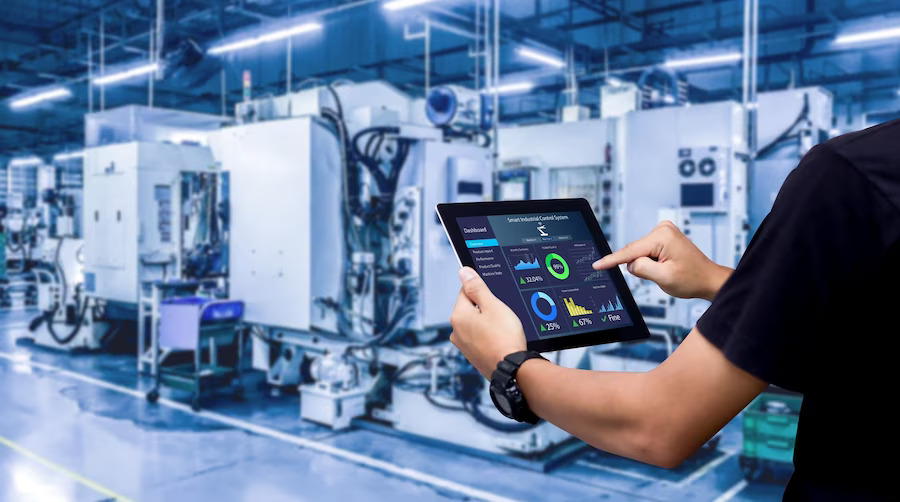The world of industrial automation is undergoing a profound transformation, thanks to the integration of the Internet of Things (IoT). Industries are becoming smarter, more efficient, and increasingly connected. In this blog, we will explore what industrial automation is, how IoT plays a pivotal role in this field, where IoT is used in industrial automation, the challenges it faces, its impact, and the future outlook.
What is Industrial Automation?
Industrial automation refers to the use of technology and control systems to operate and manage machinery and processes in various industries. It aims to reduce human intervention, enhance efficiency, improve productivity, and ensure safety in industrial operations. Automation systems can control anything from manufacturing equipment and assembly lines to power plants and chemical processes.
How IoT Plays an Important Role in Industrial Automation
IoT’s significance in industrial automation lies in its ability to connect devices, sensors, and systems to the internet, allowing them to communicate and share data in real-time. Here’s how IoT revolutionizes industrial automation:
- Remote Monitoring and Control: IoT enables remote monitoring and control of industrial processes and equipment. This means engineers and operators can access real-time data and make adjustments from anywhere, enhancing operational flexibility and efficiency.
- Predictive Maintenance: IoT sensors collect data on the condition of machines and equipment. Advanced analytics and machine learning algorithms can predict when maintenance is needed, reducing downtime and preventing costly breakdowns.
- Data Analytics: IoT generates vast amounts of data that can be analyzed to identify trends, optimize processes, and improve decision-making. This data-driven approach leads to more informed and efficient operations.
- Energy Efficiency: Industrial IoT systems can monitor energy consumption and help industries reduce their carbon footprint by optimizing energy usage.
- Safety: IoT can enhance workplace safety by providing real-time data on hazardous conditions or equipment malfunctions, allowing for quick responses and minimizing risks to workers.
Where is IoT Used in Industrial Automation?
IoT is applied across various industrial sectors to improve automation. Here are some examples of its applications:
1.Manufacturing:
- Smart Factories: IoT connects machines and systems on the factory floor, enabling real-time monitoring, predictive maintenance, and automation of production processes.
- Quality Control: Sensors can detect defects and anomalies in real-time, reducing product defects and waste.
2. Energy and Utilities:
- Smart Grids: IoT optimizes energy distribution, reduces power outages, and integrates renewable energy sources into the grid.
- Water Management: IoT sensors monitor water quality, detect leaks, and improve water treatment processes.
3. Oil and Gas:
- Asset Management: IoT helps manage remote and critical assets, ensuring their proper functioning and reducing downtime.
- Safety: IoT systems monitor equipment, pipelines, and workers for safety compliance.
4. Agriculture:
- Precision Agriculture: IoT sensors collect data on soil conditions, weather, and crop health to optimize farming practices and increase yields.
5. Logistics and Supply Chain:
- Inventory Management: IoT helps track the location and condition of goods in real-time, improving supply chain visibility and reducing losses.
Challenges of IoT in Industrial Automation
While IoT offers substantial benefits, it also faces some challenges in the industrial automation sector:
1. Security:
Ensuring the security of IoT devices and networks is crucial, as cyberattacks can have severe consequences in industrial settings.
2. Interoperability:
Integrating various IoT devices and systems from different manufacturers can be complex and may require standardized protocols.
3.Data Management:
Handling and analyzing the enormous volume of data generated by IoT devices can be challenging and requires advanced analytics capabilities.
4.Costs:
The initial investment in IoT infrastructure can be significant, which may deter some industries from adopting these technologies.
The Impact of IoT in Industrial Automation
The integration of IoT in industrial automation has far-reaching impacts:
- Improved Efficiency: IoT-driven automation streamlines processes, reduces waste, and enhances overall operational efficiency.
- Cost Reduction: Predictive maintenance and optimized resource usage can lead to cost savings by minimizing downtime and energy consumption.
- Safety: IoT enhances safety by providing real-time monitoring and alerting systems for hazardous conditions.
- Sustainability: Industrial IoT solutions help industries reduce their environmental footprint by optimizing resource usage and energy efficiency.
Future Outlook of Industrial Automation
The future of industrial automation looks promising with IoT at its core:
- Greater Integration: IoT will continue to integrate with other emerging technologies like artificial intelligence (AI) and blockchain, creating even more efficient and secure automation systems.
- Customization: Industries will increasingly adopt IoT solutions tailored to their specific needs, allowing for more flexible and adaptable automation.
- Edge Computing: Edge devices will become more powerful, enabling real-time data processing and decision-making at the source, reducing latency.
- 5G Connectivity: The rollout of 5G networks will further enhance IoT capabilities, enabling faster and more reliable connections for industrial applications.
Conclusion
The fusion of IoT and industrial automation is revolutionizing industries across the board. It is enhancing efficiency, productivity, and safety while also reducing costs and environmental impact. While challenges like security and interoperability exist, the benefits of IoT in industrial automation far outweigh these concerns. As technology continues to evolve, we can expect to see even more innovative solutions emerge, further transforming the way industries operate and paving the way for a smarter and more connected industrial landscape. The future is bright for industrial automation, and IoT is at the forefront of this exciting journey.






